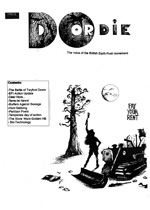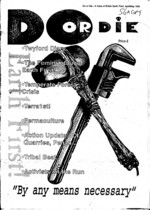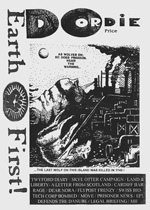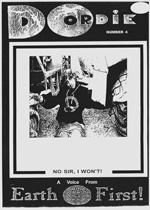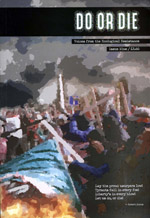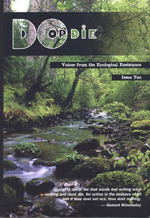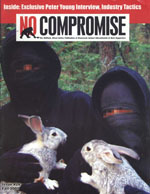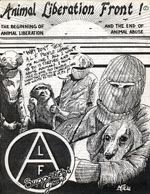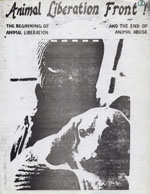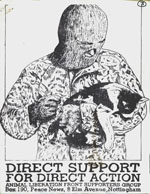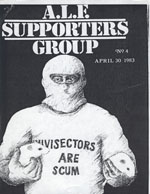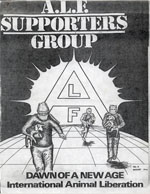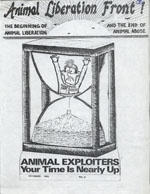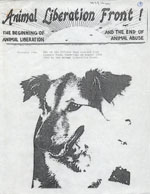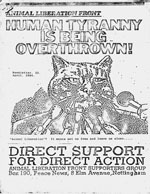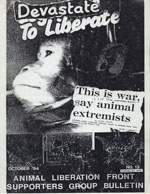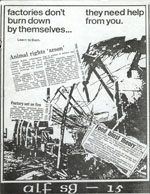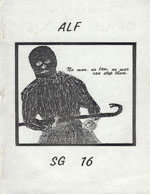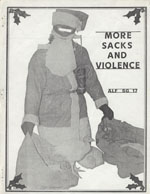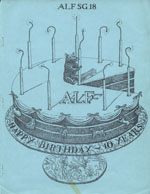The Archives
-
Do or Die, Most Popular, Periodicals
Do or Die – The Complete Set!
04.09.14 | PermalinkDo Or Die #1-10 (1993-2003, Brighton, England.)
A few years ago a friend asked me if I had a complete set of Do or Die, the British Earth First! publication that inspired and incited eco-warriors throughout the 1990s and early 2000s. At one time I did have them, but they had long since been stolen by a Joint Terrorism Task Force.
After a brief discussion, we decided that Do or Die was too important to fade into obscurity. We began tracking down each issue, and decided that while we were at it we ought to archive some other publications as well. That effort is how this web site began, and now, thanks to 56a infoshop of South London and Tim @ NEDS Northampton, we can finally share the very rare issue #2. This completes our collection, and our original mission as well.
When read as a set, Do or Die is a chronicle of people from across the globe counter-striking capitalism, ecocide, and the state. Each issue is better than the last, but more importantly, each page is a spark licking at the fuse of the bomb that is your heart. Once lit, you’ll know that these pages are not mere history, but a reminder that we can explode onto the world stage like the fighters before us have. Do or die, now is the time to rise.
…
-
Periodicals
The SG newsletter, Volume 2.
07.08.13 | PermalinkSupporters Group Newsletter No.1 (1987 – London, England)
After the original Animal Liberation Front Supporters Group newsletter was repressed out of existence, an attempt was made at a second volume that could survive government harassment. Steps were taken to clear each article with attorneys and the majority of the content was reposted from mainstream news articles. Calls to action were kept out of editorials written by the SG (Although they still appeared in the many first hand accounts and communications sent from those underground) and, in general, the tone was far less militaristic than the final issues of Volume 1.
Sadly, this didn’t save the SG’s volunteers from further political prosecutions.
During this time British security services estimated that up to four hundred direct actions were happening every day in the United Kingdom, with more financial damage being incurred by animal abusers than the British government faced at the hands of the IRA in Northern Ireland. The state was not willing to risk these actions spreading no matter how legal the efforts of those publicising them. So, after a single, wonderful issue, the SG newsletter was once again put out of business. At least they went down fighting! This newsletter features inspiring reports, hilariously snarky editorials, and some of our favorite images from the frontlines of the fight against speciesism. It is truly a must read, and we are proud that, despite the efforts of Scotland Yard and other British law enforcement, The SG is still available here at TALON.
…
-
Do or Die, Periodicals
Do or Die #9
03.27.13 | PermalinkDo or Die #9 (2000, Brighton, England.)
We always write the same thing when we post an issue of Do or Die, so this time we will spare you the superlatives. This issue has worldwide ecological news, human freedom struggles, non-human direct action, and a radical history of football alongside a little bit of humor and many inspiring images. A must read, so click below and get to it!
…
-
No Compromise, Periodicals
No Compromise #27-28
03.18.13 | PermalinkNo Compromise #27-28 (2005. Santa Cruz / San Francisco, CA)
The volunteer staff of No Compromise may have only published two issues in 2005, but both were valuable sources of news and ideas from across the globe. As always, the reports inside are bitter sweet. Many animals were rescued, many abusers felt some heat, and many people rose up and fought back. Then, there was the backlash, the senate hearings, and the arrests. The movement has never stopped though, and No Comp always served as a reminder that come hell or high water we were all going to forge ahead, sometimes stronger, sometimes weaker.
One unfortunate development in 2005 was the arrest and conviction of Chris “Dirt” McIntosh. Despite receiving movement support, Chris turned to Nazi groups in prison for advice and friendship. Soon, he counted himself among their ranks, and requested to be removed from animal lib prisoner lists. He would have been removed anyway though: there is never room in our struggle for a Nazi!
Luckily, other prisoners continued to show courage, dignity, and resolve from behind bars. Both 2005 issues of NC contain inspiring letters and interviews with jailed comrades. All in all, this is another must read year for the best animal liberation publication to come out of the United States.
…
-
Most Popular, Periodicals, The SG (original 80s volume)
The ALF Supporters Group Newsletter – The complete original set!
03.04.13 | PermalinkThe ALF Supporters Group Newsletter #1-19 (1982-1986. Nottingham / London, England)
When this archive project was founded two years ago, a list was made of the ten publications that we “had to have.” Number one was a complete set of the first volume of “The SG.” This was a tall order, and we knew it. First off, the Animal Liberation Front Supporters Group must be one of the most raided entities in England, and its members were frequently raided themselves! The result was that many copies of the magazine ended up in police custody both before and after distribution, never to be seen again. Second, it was a relatively old newsletter, and since the first issues were mimeographed on cheap paper, finding intact copies was going to be difficult. We persevered though, and now these rare pieces of movement history are preserved digitally and online for everyone to read and learn from.
Started by Dave Nicholls in 1982, the ALF Supporters Group was an effort to do two things: 1.) To raise funds for people arrested for animal related direct actions. 2.) To create a broader base of support for the Animal Liberation Front inside the movement. Both goals were met quickly. Within two weeks of their founding, the Supporters Group hit the number of members they had set as their long term goal. Through direct donations, memberships, fundraising events, and sales of merchandise, the SG was able to contribute towards the sizable legal costs of activists being arrested across England.
The newsletter itself went through varying degrees of quality in writing, layout, and value to the movement. The early days of the Nicholls run may have had a drab interior, but the hand illustrated covers were sometimes gorgeous, and the rhetoric had not yet strayed into the more-militant-than-thou nonsense which came later. Eventually the writing would border on the cultish, but there is scarcely an issue of the magazine that doesn’t have some redeeming value. When read critically and as a whole body of work, this magazine follows the rise and spread of underground action for animals across the globe, illustrates the value of coalition building, and provides solid examples of extremism to be avoided through coverage of groups like the Animal Rights Militia. It also provides many historical details found nowhere else!
“The SG” has gone through several incarnations since British Law enforcement shut this one down in 1986. (While carrying out the investigation for the notorious Sheffield trial that sent Ronnie Lee to prison for 10 years, the police raided the SG and charged it’s editors with incitement. Everything published by the SG afterwords had to be run past a lawyer first, but this didn’t stop further raids, arrests, and convictions of those involved in the newsletter.) It is still being published today, copies can be ordered from www.alfsg.org.uk.
Finally, an excellent analysis and critique of the SG and the rise of England’s “Cult of Militancy” can be found in the book Against All Odds, available here at the Talon Conspiracy.
…
-
Do or Die, Periodicals
Do or Die #8
10.03.12 | PermalinkDo or Die #8 (1999, Brighton, England.)
There is nothing to say about Do or Die that has not already been said on this website- it was the best environmental journal in history and this issue is full of the same critical theory, inspiring coverage, and beautiful graphics as every other issue. What makes this volume unique though is the in depth coverage of J18, the so-called “Carnival Against Capital” that rocked the world in 1999 before being quickly forgotten. Also of interest is the recurring “Animal Antics” feature, and hundreds of pages of indigenous resistance, radical history, eco-feminism, and direct action coverage. As we have said before, Do or Die is a must read, and this issue is no exception.

-
Do or Die, Periodicals
Do or Die #7
01.30.12 | PermalinkDo or Die #7 (1998, Brighton, England.)
The genesis of Conflict Gypsy came from our founder’s desire to collect and preserve a complete set of Do or Die, the classic British Earth First! publication. While we still have not found copies of issues 1-4, our posting of these book sized epics continues with issue #7.
Do or Die was always reasonably free of the acritical cheer leading of it’s many American counterparts, and this issue manages an honest examination of the limitations and capabilities of direct action campaigns from Poland to Brazil to Mexico. As always, there is a bittersweet mixture of inspiration and despair while reading about the clashes between the oppressed and the powers of the state and industry, but there are enough victories contained in this volume that elation prevails! You will cheer as the black bloc escapes arrests in Derbyshire by switching into hippie clothing and shouting “no violence” as the police roll in (An activist in England nearly pissed themselves telling me that story one night!) and as wild boars recruit domesticated pigs for non-human resistance to domestication. The power of villagers in India to stop dams lessens the pain of reading about the paramilitary massacres of people in Acteal, and other articles will have you thinking deeply about our movements DIY media efforts, prison support, and coalitions with labor groups. All in all, another must read from one of the most exciting periods of resistance in the 20th century.
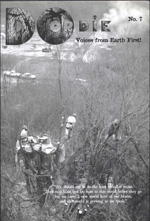
-
Periodicals, Videos
Breaking Free Video Magazine #2
12.19.11 | PermalinkBreaking Free #2 (1999, Eugene, OR.)
The second and final episode of Breaking Free has some glaring faults: jokes that are not funny, computer animation that is antiquated and was already embarrassing upon it’s release, and no shortage of bad titling choices. It also contains footage of some of the most important and influential campaigns of the era it was produced, especially the Consort Kennels and Hillgrove protests which eventually led to the international fight against Huntingdon Life Sciences. Many long forgotten ALF raids are also shown, along with the final major civil disobedience actions at the end of the voluntary arrest era of the 1990s.
…
